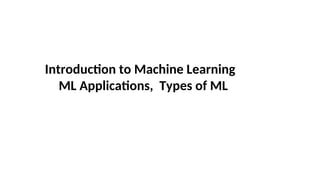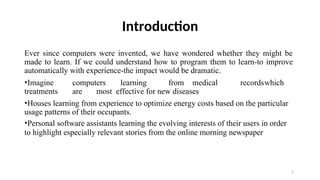2.ml-applicationanswellas unit 2and other content.ppt
- 1. Introduction to Machine Learning ML Applications, Types of ML
- 2. 2 Introduction Ever since computers were invented, we have wondered whether they might be made to learn. If we could understand how to program them to learn-to improve automatically with experience-the impact would be dramatic. •Imagine computers learning from medical recordswhich treatments are most effective for new diseases •Houses learning from experience to optimize energy costs based on the particular usage patterns of their occupants. •Personal software assistants learning the evolving interests of their users in order to highlight especially relevant stories from the online morning newspaper
- 3. 3 Examples of Successful Applications of Machine Learning • Learning to recognize spoken words • Learning to drive an autonomous vehicle • Learning to classify new astronomical structures • Learning to play world-class backgammon
- 4. 4 Why is Machine Learning Important? • Some tasks cannot be defined well, except by examples (e.g., recognizing people). • Relationships and correlations can be hidden within large amounts of data. Machine Learning/Data Mining may be able to find these relationships. • Human designers often produce machines that do not work as well as desired in the environments in which they are used. • The amount of knowledge available about certain tasks might be too large for explicit encoding by humans (e.g., medical diagnostic). • Environments change over time. • New knowledge about tasks is constantly being discovered by humans. It may be difficult to continuously re-design systems “by hand”.
- 5. 5 Areas of Influence for Machine Learning • Statistics: How best to use samples drawn from unknown probability distributions to help decide from which distribution some new sample is drawn? • Brain Models: Non-linear elements with weighted inputs (Artificial Neural Networks) have been suggested as simple models of biological neurons. • Adaptive Control Theory: How to deal with controlling a process having unknown parameters that must be estimated during operation? • Psychology: How to model human performance on various learning tasks? • Artificial Intelligence: How to write algorithms to acquire the knowledge humans are able to acquire, at least, as well as humans? • Evolutionary Models: How to model certain aspects of biological evolution to improve the performance of computer programs?
- 6. 6 Machine Learning: A Definition A computer program is said to learn from experience E with respect to some class of tasks T and performance measure P, if its performance at tasks in T, as measured by P, improves with experience E.
- 7. 7 Why “Learn”? Learning is used when: •Human expertise does not exist (navigating on Mars) •Humans are unable to explain their expertise (speech recognition) •Solution changes in time (routing on a computer network) •Solution needs to be adapted to particular cases (user biometrics)






